This first table shows the SR2’s Watts/10 Delta Temp numbers in a quick glance chart format.
Using the data compiled from the SR2 thermal testing I have compiled the following tables in an attempt to show other ways of how its performance varies against itself at the flow rates and fan speeds tested. Effectively these show percentage gains relative to a reference point. It’s an interesting way to show gains/losses while changing a variable. First let’s focus on 1300 RPM as our reference and see how much gain or loss in performance we get by changing fan speed.
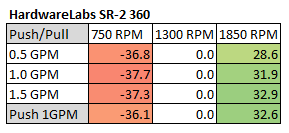 The high percentage changes from 1300 rpm to 750 rpm appear to indicate the SR2 is tuned for best performance somewhere in this fan speed range. In the next plot we focus on changing the flow rate with 1.0 GPM as the base line.
The high percentage changes from 1300 rpm to 750 rpm appear to indicate the SR2 is tuned for best performance somewhere in this fan speed range. In the next plot we focus on changing the flow rate with 1.0 GPM as the base line.
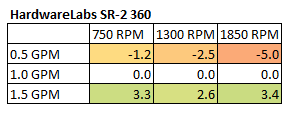 With only slight percentage changes with varying the flow rate could mean a couple of things. The flow rate is not a determining factor for performance on the SR2 or that the core is extremely well tuned for a low flow rate and little performance gains are made with increasing flow rates. I tend to favor the later as the most likely scenario.
With only slight percentage changes with varying the flow rate could mean a couple of things. The flow rate is not a determining factor for performance on the SR2 or that the core is extremely well tuned for a low flow rate and little performance gains are made with increasing flow rates. I tend to favor the later as the most likely scenario.
How about we combine both flow rate and fan speed as reference points and have a look at 0.5 GPM & 750 RPM as the reference point.
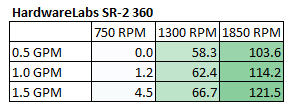 This unintentionally shows us quite nicely that not much performance is gained with flow rate increases.
This unintentionally shows us quite nicely that not much performance is gained with flow rate increases.
Lastly, we change the reference and choose our center 1300 RPM and 1.0 GPM as our reference point to show both effects concurrently:
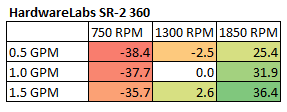 It’s an interesting plot that ties in the theories that were being made as the previous plots were analysed.
It’s an interesting plot that ties in the theories that were being made as the previous plots were analysed.
So from the data above we can get a very good idea of how the SR2 radiator performs relative to itself. But there is a large selection of 360mm radiator models to choose from, released from numerous manufacturers. So, we need to start comparing performance between them. To see how the SR2 performed against the other radiators tested, I have included the averaged flow rate comparison charts from the Round Up. We know that the flow rate has little impact on thermal performance so averaging of the 3 flow rate results gives us a good look at head to head performance at the rpm speeds tested at with even less error.
Push Only Data vs Competition
Let’s focus on the Push Only results for now and come back to the Push/Pull data later. While for Push/Pull we tested three flow rates, the Push Only testing was conducted only at 1GPM in order to save time.
Let’s start with 750 RPM and see how it compares to the competition:
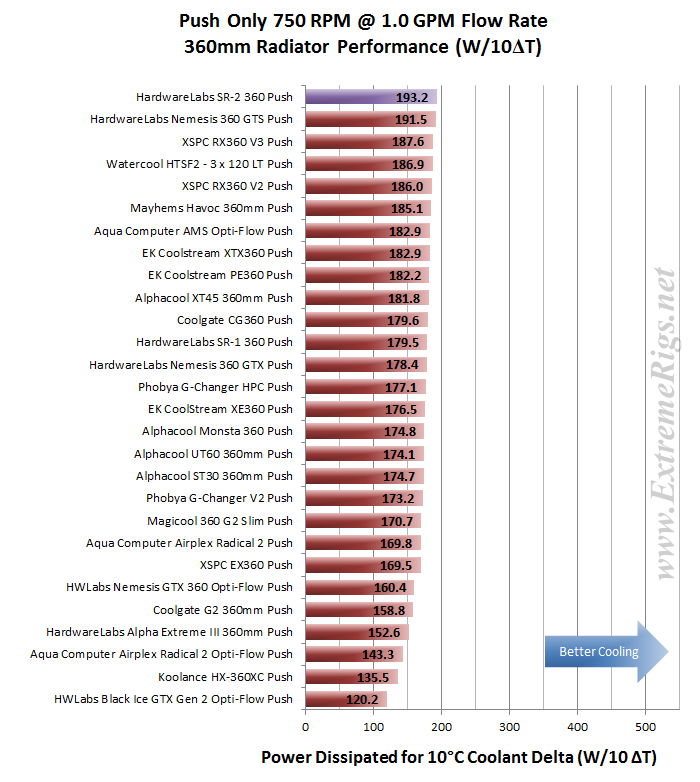 What a way to start! At low fan speeds the SR2 is straight to the top of the Push Only comparison charts!
What a way to start! At low fan speeds the SR2 is straight to the top of the Push Only comparison charts!
How does the SR2 do at 1300 rpm?
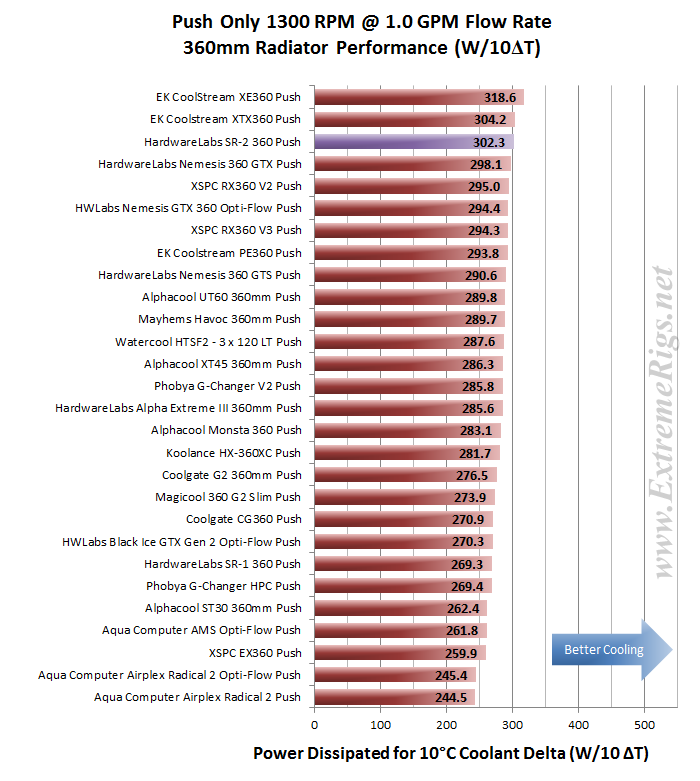 Placing third it is close behind the winner.
Placing third it is close behind the winner.
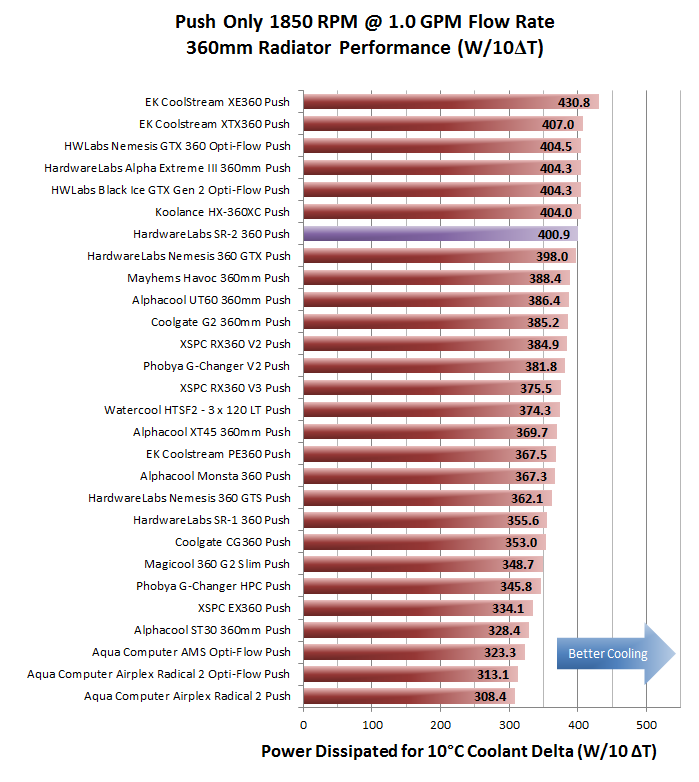 At 1850 Push Only the SR2 drops a few spots and placed 7th, just 1.5% behind the second place radiator. Hardware Labs really dominates this testing point with 5 of the top 8 performers in the high-speed fan Push Only category.
At 1850 Push Only the SR2 drops a few spots and placed 7th, just 1.5% behind the second place radiator. Hardware Labs really dominates this testing point with 5 of the top 8 performers in the high-speed fan Push Only category.
So it appears (as expected given the low FPI count) that the SR2 is well tuned for low fan speeds. Will the SR2 perform similar to other low FPI rads where they perform best in Push Only applications, or can the SR2 hold its own in Push/Pull also?
Let’s find out….
Push/Pull Data vs. Competition
Let’s now look at the Push/Pull results and see how the SR2 compares. For Push/Pull we have averaged the results from the 3 flow rates at which we tested.
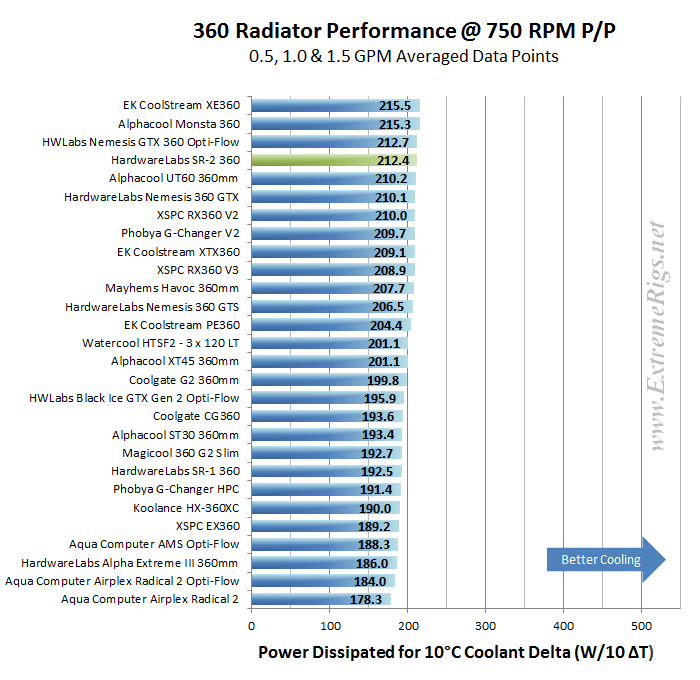 The SR2 finished in 4th position in the Push/Pull low fan speed category. This is an excellent result when averaged over the 3 flow rates.
The SR2 finished in 4th position in the Push/Pull low fan speed category. This is an excellent result when averaged over the 3 flow rates.
Let’s move to the 1300 rpm then…..
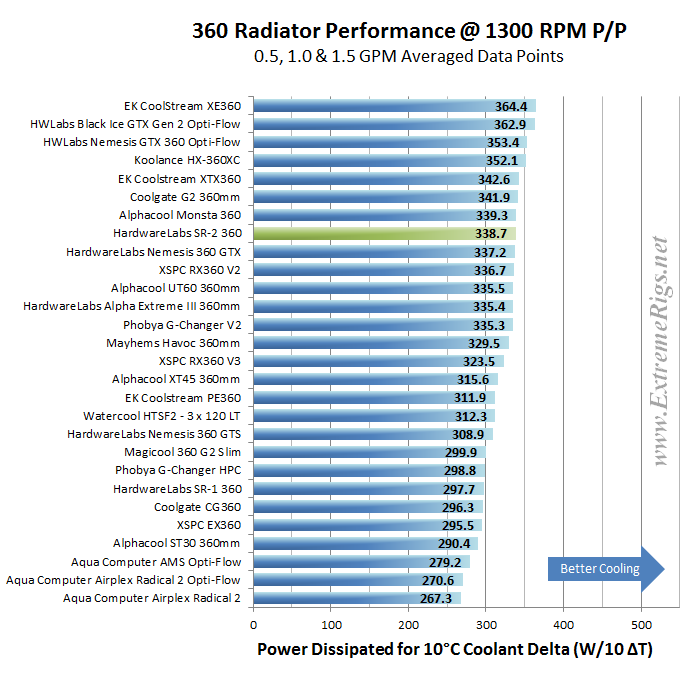 In the 1300 rpm category the SR2 has dropped down the leader table to finish in 8th. A relatively poor 1.5 gpm rpm result held it back in the averaged results, as in the lower flow rates it placed 5th in both.
In the 1300 rpm category the SR2 has dropped down the leader table to finish in 8th. A relatively poor 1.5 gpm rpm result held it back in the averaged results, as in the lower flow rates it placed 5th in both.
The averaged 1850 rpm results…
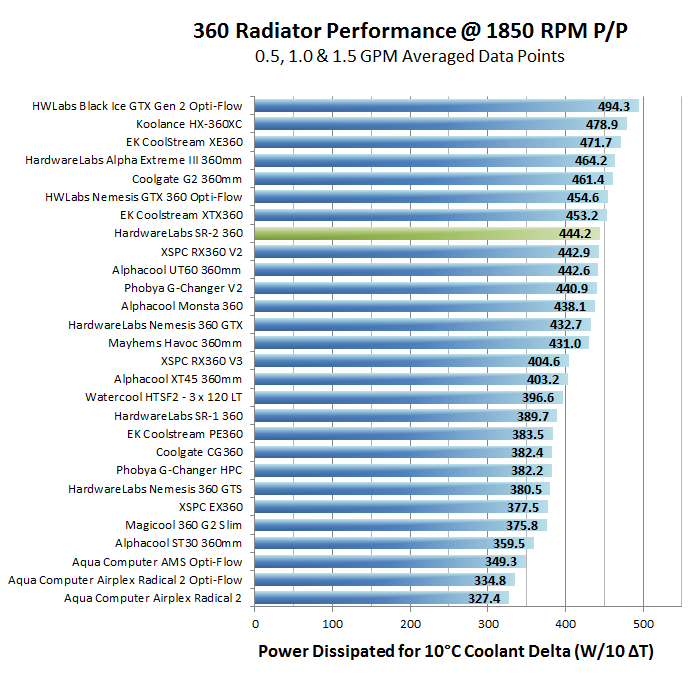 At 1850 Push/Pull the SR2 holds its ground in the rankings but falls a bit further behind the leaders, now around 10% behind the winner.
At 1850 Push/Pull the SR2 holds its ground in the rankings but falls a bit further behind the leaders, now around 10% behind the winner.
Let’s now also combine the Push and Push/Pull results at the 1.0 GPM flow rate into one plot for each fan speed tested.
Again the 750 rpm first…
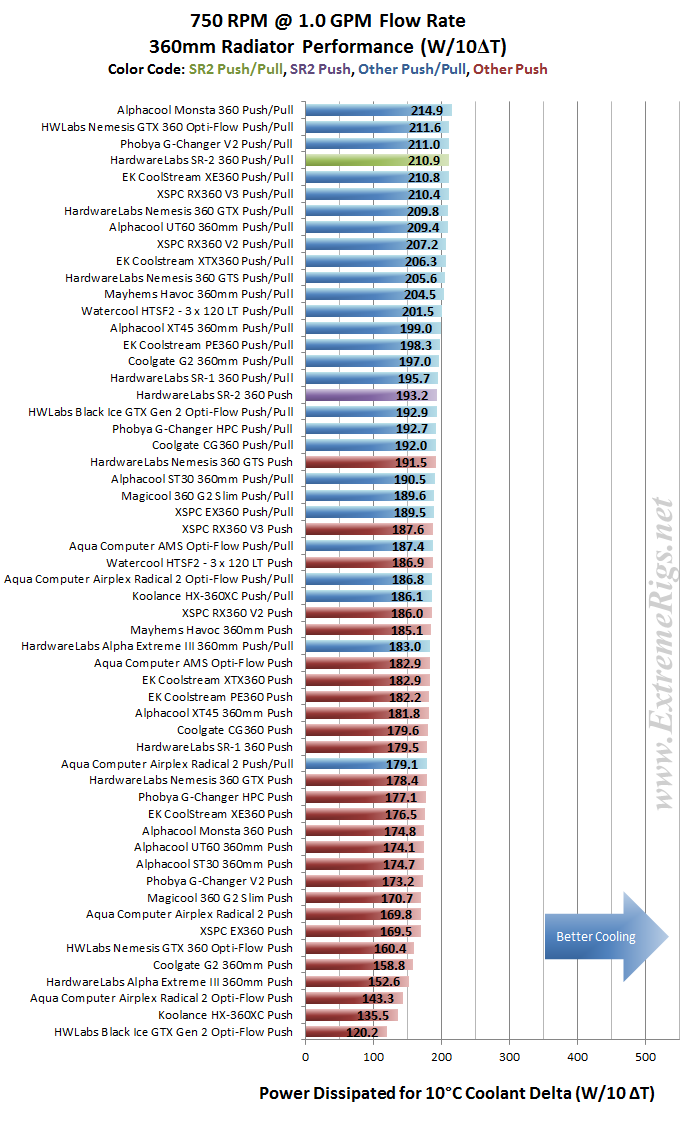 Nothing looks out of place here given the data we have reviewed already. Interestingly the Push Only result beats out nearly half of the other radiator’s Push/Pull results!
Nothing looks out of place here given the data we have reviewed already. Interestingly the Push Only result beats out nearly half of the other radiator’s Push/Pull results!
At 1300 rpm:
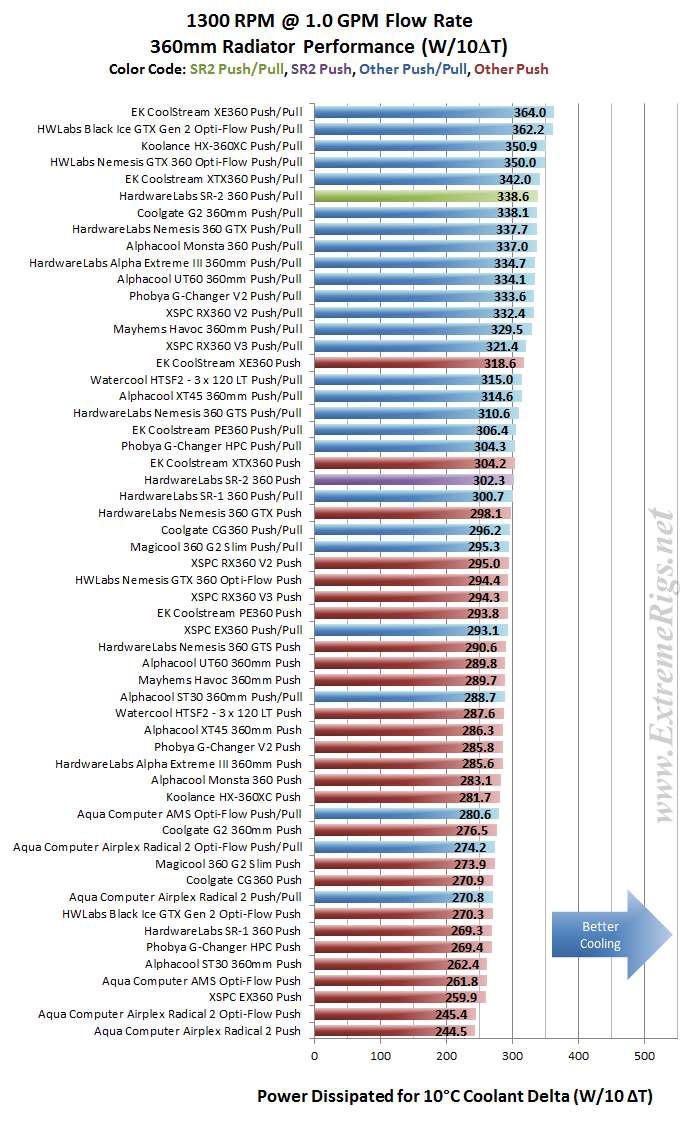 At 1300 rpm everything looks in order given the data we’ve already reviewed.
At 1300 rpm everything looks in order given the data we’ve already reviewed.
Same with the 1850 RPM combined plot:
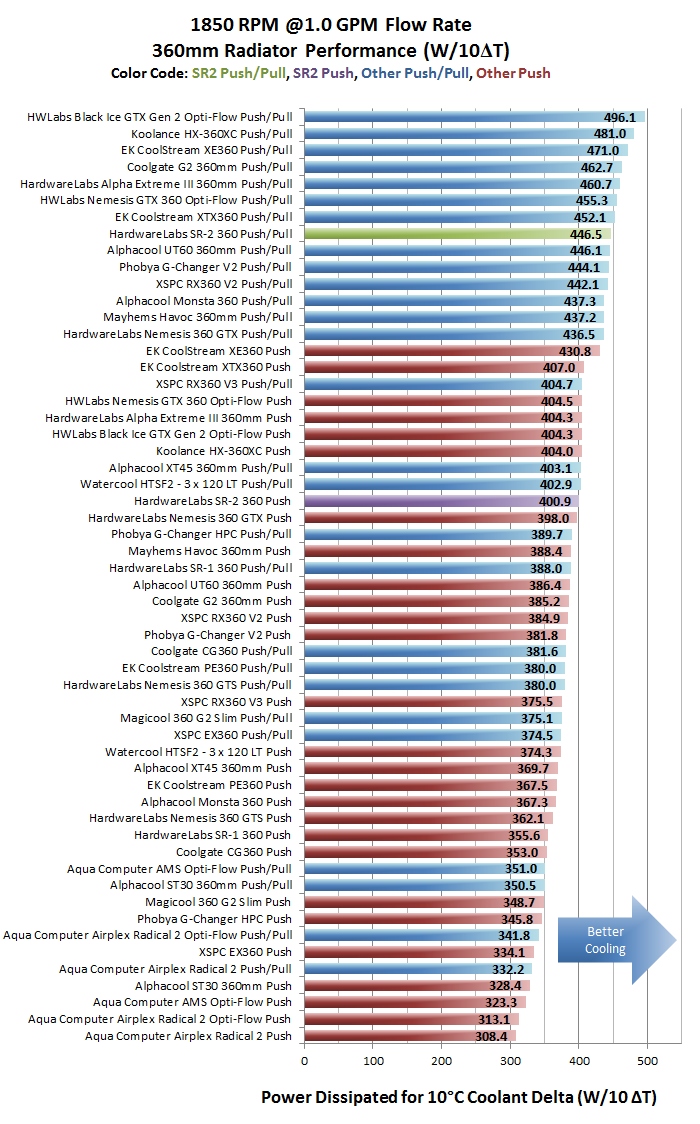 From all of test results we created “Average Performance Factor” charts for both Push and Push/Pull and then a combined plot called the “Master Performance Factor”. The radiator with the best cooling ability (W/10ΔT) at each gpm/rpm combo was awarded a score of 100, and each other radiators W/10ΔT result was scored as percentage of the top performer.
From all of test results we created “Average Performance Factor” charts for both Push and Push/Pull and then a combined plot called the “Master Performance Factor”. The radiator with the best cooling ability (W/10ΔT) at each gpm/rpm combo was awarded a score of 100, and each other radiators W/10ΔT result was scored as percentage of the top performer.
This way of looking at the comparison takes away any advantages that a radiator may have at higher or lower fan speeds and looks at an overall average. While this appears fair it does tend to favor those radiators that are all-rounders and those radiators which do very well at high RPM. Most users should be more focused on their specific use case. Check in the Round Up for performance comparisons at every gpm/rpm combo for even more details and cross comparison results.
Here is the SR2’s performance scores at each data point that thermal tests were conducted at. Additionally we can see how the Push Only result compared against the winners at both Push/Pull and Push Only.
The Push Only and low fan speed Push/Pull are impressive to say the least, while the others are very very respectable showing the SR2 to be an excellent all-rounder which favours the lower fan speeds a bit more.
Then we started averaging the percentage scores at each flow rate giving us the Averaged Performance Factors of each radiator.
First – the Push Only APF:
The SR2 achieved consistently high results across all fan speeds while not taking out any actual data point wins.
Now the Push/Pull APF…
The SR2’s Push/Pull APF of 93.5 places it in 6th position and I will admit higher than I had anticipated that it would prior to analyzing the data – this is presumably due to the low FPI. A pleasant surprise!
Finally we created the Master Performance Factor which is calculated from the averaged results of all the thermal tests, Push and Push/Pull at all flow rates and all fan speeds.
In the Master Performance Factor comparisons the SR2 finishes in second place! Consistent good results across all the test data points will surely earn the SR2 a “Gold” award.
I really didn’t expect the SR2 to perform so well across the board, so hats off to HWLabs for the core design they have come up with on this radiator. While optimized for low fan speeds it does an excellent job at heat dissipation no matter the flow rate or fan speed – amazing!
Next up – Summary!







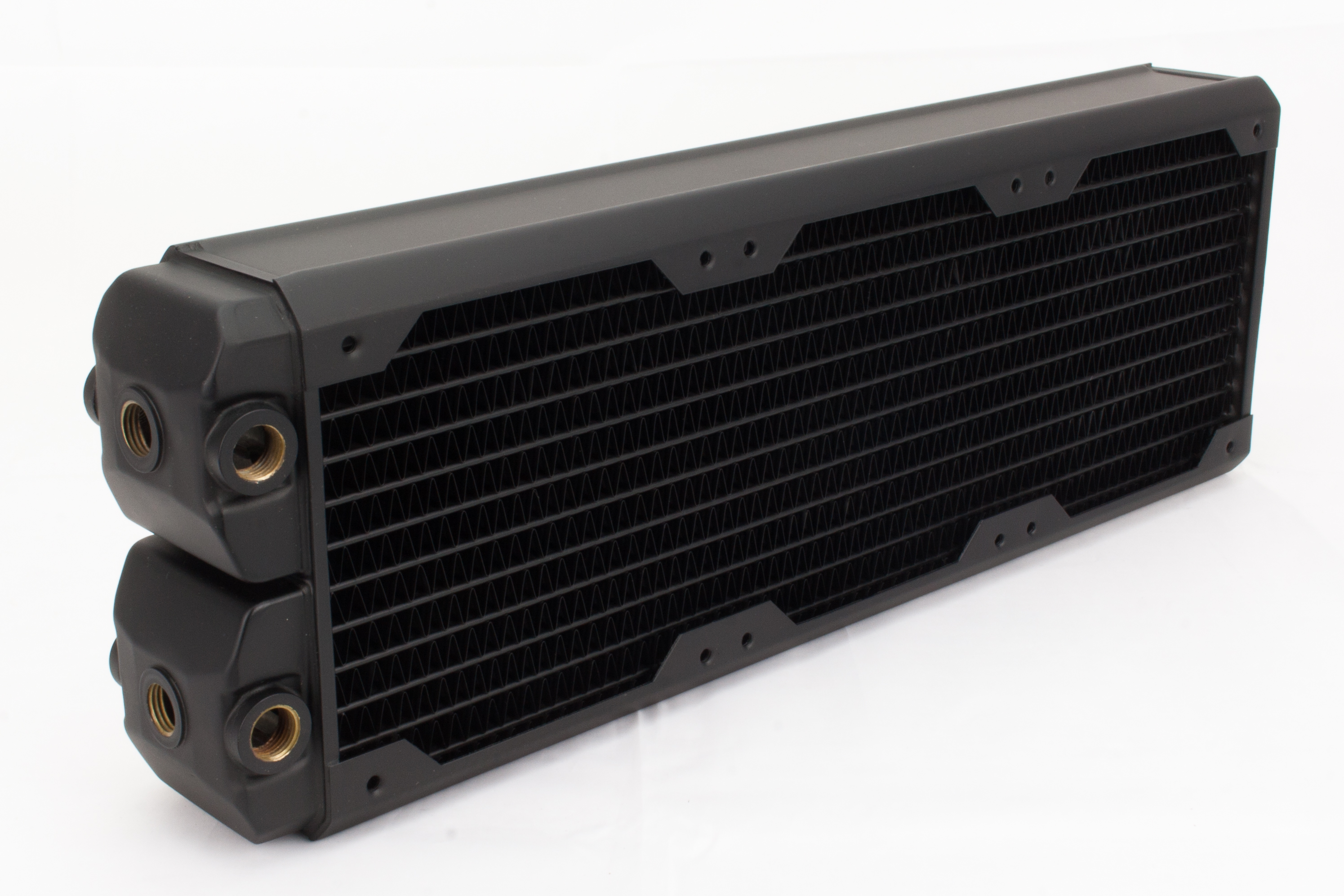
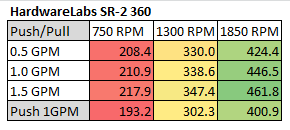
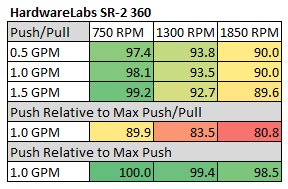
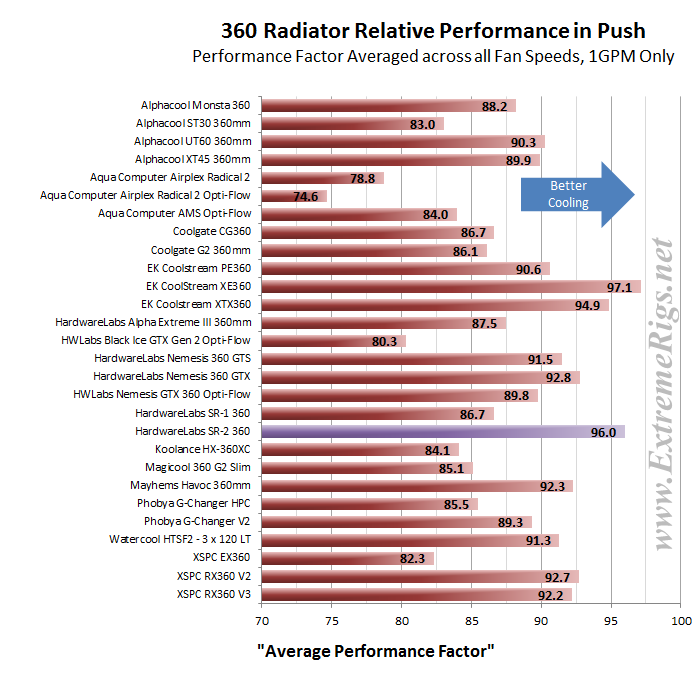
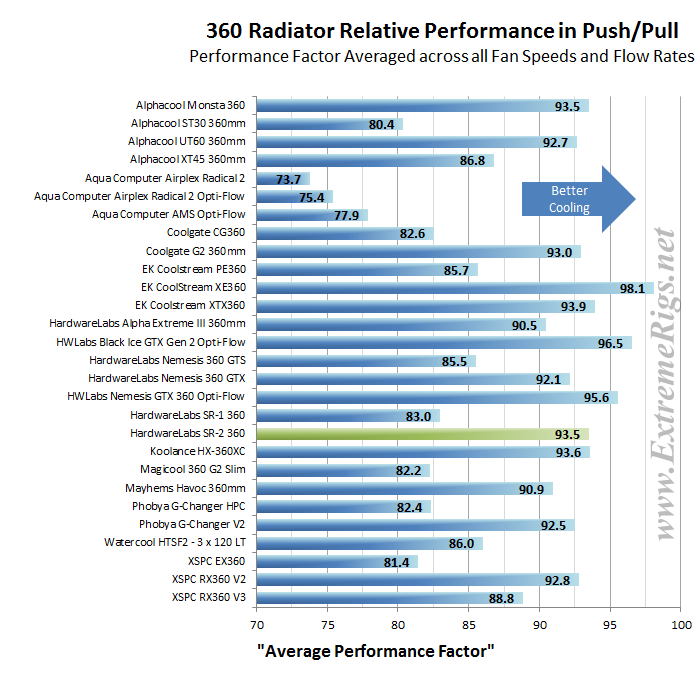
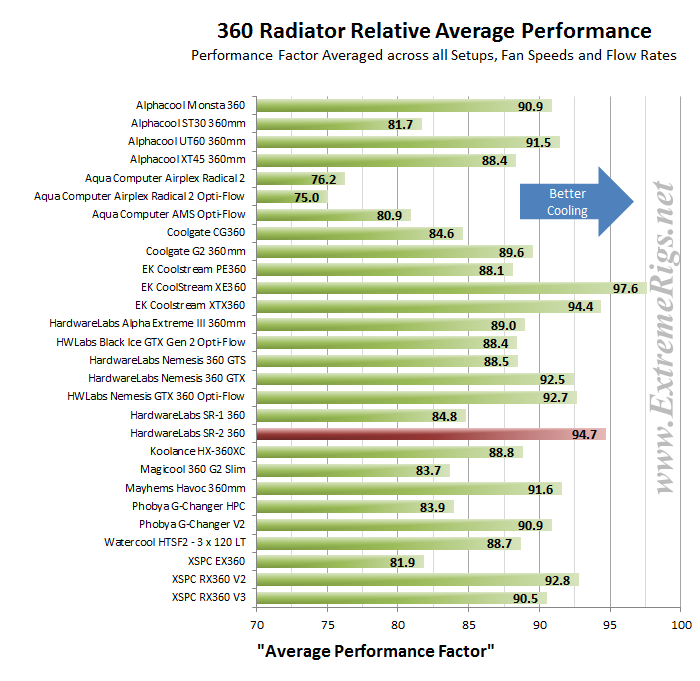



What are these “Opti-flow” versions of radiators? I can find no such variant on Hardware Labs website, only the “XFlow” variety.
Hey Thomas – the “optiflow” refers to radiators where the direction of coolant or airflow matters. “Optiflow” means that the “best” orientation is being tested. It only applies therefore to certain radiators with certain internal structures such as the Nemesis GTX or Black Ice GTX. The SR2 does not have any such directionality 🙂
Also on more thing to add – optiflow significantly helps lower flow rates when air flow is higher. If you run low airflow or high coolant flow then a directional radiator can be more of a pain than a gain.
Ah, thank you!
So between the SR2 and Nemesis GTX which performs better seems to be entirely down to the particulars of your setup then (as the Nemesis seems to straddle the SR2 results with and without opti-flow), will have to reread the Nemesis review as I don’t remember seeing anything about this issue.
Great work, love these reviews and the roundup comparisons (any chance there will be a 140mm variant of it some time too?).
Awesome review thanks for all the hard work!!
Nice review man,
I gotta get me on of this multiport when it comes out 🙂
Awesome review, I really want one too.
Great review as always
[…] Nemesis GTS 360 Radiator Hardware Labs Nemesis GTX 360 Radiator Hardware Labs SR-1 360 Radiator Hardware Labs SR2 360 Radiator Koolance HX-360XC 360 Radiator Magicool G2 Slim 360 Radiator Mayhem’s Havoc 360 Radiator […]
[…] a close look at the SR2 240 MP from Hardware Labs. We took a look a pre-production sample of the 360mm version for the round-up, so if the 360mm size is more your flavor be sure to check out it’s full review […]
If you don’t mind? What advice do you have to offer concerning the first model of SR2 radiator performance as compared to the SR2-MP? Is this simply a feature added change with the same performance? Or an attempt at both adding features while improving performance?
The SR2 and SR2 MP have the same core – there *should* be no performance difference and it should only be additional features 🙂
[…] up is the SR2 420 MP from Hardware Labs. We’ve already reviewed the 240 mm and 360mm versions of the SR2 MultiPort so be sure to check them out after you’ve finished reading this […]
[…] for sub-800 rpm ultra-stealth fans” which proved to be be an accurate statement when we tested the 360mm version earlier in the year. Will the 140mm perform as well ? We’ll find out how it performs and […]
Comments are closed.